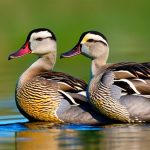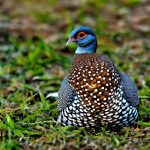If you’re someone who takes pride in raising geese, it’s only natural to find yourself wondering about the number of eggs your gaggle might gift you with each year. Peering into their nests, that question probably plays on your mind more often than not—and you aren’t alone in this.
Trust me, I know the feeling all too well; I’ve spent many a morning mentally tallying potential egg counts and longing for some kind of goosey crystal ball.
Thankfully, after rolling up my sleeves, diving deep into research, and swapping stories with fellow geese aficionados, I’ve managed to round up some pretty helpful nuggets of knowledge.
Here’s an interesting tidbit: on average, you can look forward to collecting anywhere from 20 to 40 pristine white eggs from your goose come springtime! This article is poised to demystify the ins and outs of geese egg production for you—covering everything from decoding nesting behaviors to mastering incubation techniques.
So prepare yourself—you’re about to embark on quite the enlightening journey into the world of our feathered friends and their eggy offerings. Keep reading for some truly “egg-citing” revelations!
Understanding Geese Egg Production
Geese have an average clutch size of 12-15 eggs, with factors like age, health, and environment influencing their egg production. Seasonal laying patterns also play a role in the frequency of geese egg production.
Average clutch size (12-15 eggs)
I notice my geese getting busy in the spring. That’s when they start laying eggs, lots of them! They usually lay a big bunch, from 12 to 15 in one go. We call this a clutch. Each egg is precious and means there could be a new baby goose on the way.
Different breeds of geese can have different numbers of eggs in their clutch. Take Canada geese, for example; they might only have about 2 to 8 eggs at once. But others like the Barnacle goose, well, they tend to stick around three to five eggs while living up north in the Arctic.
My job is to look out for these clutches during breeding season. Large clutches with more than ten can sometimes happen too! It depends on things like what kind of goose it is or how old she may be.
Mother Nature has her plans for each goose family size!
Factors influencing egg production
Factors influencing egg production can greatly vary among geese. Here are the key elements that influence egg production in geese:
- Age of the goose: Younger geese tend to lay fewer eggs than older ones as they mature over time.
- Environmental conditions: Geese are sensitive to changes in weather and environment, affecting their hormone regulation and egg-laying frequency.
- Nutrition: A well-balanced diet rich in protein and calcium is crucial for optimal egg production in geese.
- Breed differences: Different goose breeds have varying natural tendencies when it comes to clutch size and egg production.
- Health status: The overall health and well-being of a goose significantly impact its ability to lay eggs consistently.
- Seasonal changes: Geese are influenced by seasonal variations, with peak laying typically occurring during the spring months.
- Stress levels: High levels of stress can disrupt the egg-laying cycle of geese, leading to reduced clutch sizes or irregular laying patterns.
Seasonal laying patterns
Given the impact of environmental factors and breeding cycles, geese exhibit seasonal laying patterns. This means that the frequency and quantity of egg production can vary depending on the time of year.
For example, during the warmer months in spring and early summer, geese tend to lay a greater number of eggs compared to winter months. Additionally, certain breeds may have specific seasonal preferences for nesting and laying their eggs.
Understanding these patterns allows geese keepers to anticipate peak laying periods and adjust their management practices accordingly. By recognizing these natural rhythms, keepers can optimize their breeding programs by providing adequate support during peak times while also understanding when egg production may naturally slow down.
Incubation Process
After the geese have laid their eggs, it is important to understand the incubation process for successful hatching. This includes both natural and artificial methods, as well as proper cleaning and maintenance of the incubator.
Natural incubation
Geese usually lay a clutch of 12–15 eggs before going broody. I’ve found that the incubation period for goose eggs is around 25-28 days, and during this time, the mother goose will sit on her nest to keep the eggs warm.
The number of eggs a goose lays before sitting on them can vary depending on the species and environmental factors.
During natural incubation, geese are excellent at regulating the temperature and humidity of their nests to ensure successful hatching. It’s really fascinating how they turn their eggs regularly to maintain an even temperature throughout.
Artificial incubation
Having discussed the process of natural incubation, now let’s delve into artificial incubation. When using an incubator, maintain a constant temperature between 99 to 100 degrees Fahrenheit for optimal hatching.
Regularly turn the eggs by hand or using an automatic turner to ensure proper development. Monitor humidity levels at around 45-55% and make adjustments if necessary. Clean the incubator thoroughly before use and routinely during the incubation period to prevent bacterial contamination.
Artificial incubation ensures a controlled environment which is crucial for successful hatching. By mimicking natural conditions within the confines of an incubator, we can increase hatch rates and overall breeding success among our geese.
Providing consistent warmth, appropriate humidity levels, and regular egg turning all contribute to healthy embryo development and ultimately result in strong goslings.
Cleaning and maintenance of incubator
After ensuring the proper set up and use of the artificial incubator, it’s important to maintain a clean environment for successful hatching. Here’s how to ensure the cleanliness and maintenance of your incubator:
- Regularly clean the incubator with a mild disinfectant to prevent bacterial growth that could harm the developing embryos.
- Check and replace the bedding material or substrate regularly to maintain a hygienic environment for the eggs.
- Monitor and adjust the temperature and humidity levels according to the specific requirements for goose egg incubation.
- Inspect and clean the ventilation system to ensure proper airflow within the incubator, crucial for healthy embryo development.
- Keep a close eye on the functioning of any automated turning mechanisms and promptly address any malfunctions or irregularities.
- Conduct regular checks on all components, including thermostats, heating elements, and sensors, to ensure they are in optimal working condition.
- Store spare parts and cleaning supplies nearby to quickly address any issues that may arise during the incubation process.
- Regularly calibrate and test the accuracy of temperature and humidity gauges to maintain precise environmental control within the incubator.
- Implement biosecurity measures to minimize potential contamination risks from outside sources when accessing the incubator for maintenance.
- Keep detailed records of maintenance activities, such as cleaning schedules, component inspections, and adjustments made to incubator settings for future reference or troubleshooting purposes.
Sex Identification of Geese
Determining the sex of geese is important for breeding purposes, and there are specific methods used to identify the gender of these birds. Interested in learning more? Keep reading!
Importance for breeding purposes
Breeding geese need to accurately identify the sex of their birds. This is essential for creating compatible pairs and successful breeding programs. Knowing the sex of geese helps in selecting suitable mates, ensuring fertility, and achieving optimal egg production.
Sexing methods such as vent sexing or DNA testing can assist breeders in forming balanced breeding groups.
Creating well-matched pairs leads to successful fertilization and a higher chance of hatching healthy goslings. Properly identifying sexes within a flock also prevents same-sex pairings which cannot produce offspring.
Methods of sexing geese
Determining the sex of geese is essential for breeding. Here are methods to identify the gender:
- Vent sexing – This method involves examining the cloaca to determine the presence of male or female genitalia.
- Feather sexing – It relies on differences in feather growth patterns and coloration between males and females.
- Behavioral cues – Observation of mating behaviors and territorial displays can indicate gender.
- DNA testing – Utilizing genetic testing to accurately determine the sex of geese.
Cooking and Eating Goose Eggs
Goose eggs are a rich source of nutrients and can be cooked in various ways to create delicious meals – read on to discover the nutritional value, cooking techniques, and availability for consumption.
Nutritional value
Goose eggs are a good source of protein, vitamins, and minerals. They contain more Vitamin E, A, and D than chicken eggs. Additionally, goose eggs have higher levels of Omega-3 fatty acids which are beneficial for heart health.
These nutrient-rich eggs can be an excellent addition to your diet or used in various recipes due to their larger size and rich flavor.
The nutritional value of goose eggs makes them a popular choice among people seeking alternative sources of high-quality protein and essential nutrients. Incorporating these nutrient-dense eggs into your diet can offer numerous health benefits while also adding variety to your meals.
Cooking techniques
Goose eggs can be boiled, fried, scrambled, or used in baking and cooking. They are larger than chicken eggs, so adjust cooking times accordingly. Some dishes to try include frittatas, omelets, and custards. When preparing goose eggs, remember that they have a rich flavor and a high yolk-to-white ratio. Additionally, consider using them in place of chicken eggs for added richness and depth of flavor.
Availability and consumption
Goose eggs are typically available in the springtime, with some breeds laying an average of 20 to 40 white eggs. It’s important to collect the eggs daily for consumption or incubation to ensure freshness.
When consuming goose eggs, keep in mind that they have a richer flavor and larger yolk compared to chicken eggs. Cooking techniques like scrambling, baking, and frying can be used to enjoy these nutrient-rich eggs.
By incorporating them into your diet, you benefit from their high protein content and essential nutrients.
Frequently Asked Questions
– Wondering how many eggs geese lay per clutch? Curious about the incubation period or specific breeds known for larger clutches? Find the answers to these and more common questions about geese egg production.
Average number of eggs per clutch
Geese usually lay a clutch of 12-15 eggs and then go broody. On average, geese lay between 4 to 10 eggs per clutch, but some species may produce up to 15 or more eggs. Clutch size variation is due to different factors such as species and individual bird characteristics.
For example, Canada geese have a clutch size of 2-8 eggs while wild geese typically lay anywhere from one to ten eggs in a clutch. Arctic-breeding barnacle geese generally have clutches of 3 to 5 eggs.
The number of eggs a goose lays before sitting on them can vary depending on the species and environmental factors like age and breed. So, keep an eye out for your specific goose’s laying patterns!
Incubation period
The incubation period for goose eggs typically lasts around 25-28 days. During this time, the eggs need to be kept at a constant temperature and humidity level for successful hatching.
It’s important to regularly turn the eggs during the incubation period to ensure even heat distribution and proper development of the embryos. Maintaining cleanliness is crucial in preventing contamination and ensuring a healthy environment for the developing goslings.
Once the incubation period is complete, you can expect adorable goslings to hatch from the eggs! The exact timing may vary slightly depending on factors such as breed and environmental conditions, but overall, it’s an exciting time to witness new life entering your flock.
Specific breeds known for larger clutches
Some goose breeds are known for laying larger clutches of eggs. For example, Embden and Toulouse geese are recognized for producing larger clutch sizes compared to other breeds. Embden geese can lay up to 15 or more eggs in a single clutch while Toulouse geese also tend to lay substantial numbers of eggs.
Understanding the breeding characteristics of specific goose breeds can help in managing egg production effectively.
Barnacle geese, commonly found in Arctic regions, usually lay a relatively smaller clutch size of 3 to 5 eggs. On the other hand, Canada geese typically produce between one and ten eggs per clutch but tend to have an average nesting size of five to six eggs.
Recognizing these differences among various breeds is crucial for effective breeding strategies and management practices when raising different types of geese.
Signs of a goose starting to sit on eggs
A goose will start sitting on her eggs when she spends most of her time in the nest and becomes protective. She might hiss or flap her wings if anyone approaches, showing a strong attachment to the nest.
Often, she’ll pluck down from her body to line the nest before laying the eggs. Once this behavior begins, it’s a clear sign that she’s ready to incubate and hatch her clutch.
Geese keepers notice that their geese become increasingly territorial over their nesting area. They may also see them settling into the nest more often than usual and displaying aggressive behavior if approached.
Common issues during incubation process
During the incubation process, maintaining proper temperature and humidity levels is crucial. Goose eggs need a consistent temperature of around 99.5 degrees Fahrenheit with 55-60% relative humidity.
Fluctuations in these conditions can lead to developmental issues or even poor hatching rates. Also, ensuring regular turning of the eggs is vital for uniform heat distribution and embryonic development.
Maintaining cleanliness in the nesting area and handling eggs with care are essential to prevent contamination or damage to the embryos. Additionally, monitoring for signs of egg infertility or malpositioning early on can help address potential problems before they impact the entire clutch.
Regularly inspecting for any damaged or cracked eggs is important as they might release bacteria which could harm viable embryos.
Hatch timeline
The last stage of incubation is the hatch timeline. Once the average incubation period of 25-28 days for goose eggs elapses, it’s time to anticipate hatching. Canada geese typically lay between one and ten eggs in a nest, with an average clutch size being about five to six eggs.
After this period, goslings start pecking and cracking their way out of the shell using an egg tooth on their beak.
Once hatched, goslings are covered in down and quickly dry off before following their parents to water. During this phase, they stay close to the parents as they learn how to feed themselves and navigate their surroundings.
Conclusion
In conclusion, geese generally lay a clutch of 12–15 eggs and then go broody. This variation is influenced by factors such as species and individual bird characteristics. Understanding these patterns can assist in managing breeding practices efficiently.
Implementing the discussed strategies can lead to significant improvements in egg production outcomes for geese keepers. Explore further resources or expert guidance to enhance your knowledge on this topic.
Take action on these practical insights to optimize your geese egg production experience!
FAQs
1. How many eggs do geese lay at one time?
Geese can lay a clutch of about 5 to 6 eggs, but some may lay more depending on the breed and their nesting habits.
2. What is goose egg production like during the year?
Goose egg laying frequency varies with species; however, most geese lay eggs in springtime when conditions are right for their arctic breeding cycle.
3. Are all the eggs that geese lay fertilized?
Not every egg will be fertilized. To get fertilized eggs, a male goose must mate with the female before she lays her eggs.
4. How does temperature affect goose egg hatching?
The right egg hatching temperature is crucial—geese use nest defense to keep their nests warm so that the incubation leads to healthy nestlings.
5. Can you tell me about geese’s nesting period and broodiness?
After laying her full clutch, a goose becomes very broody, sitting tightly on her nest for around four weeks—the typical nesting period until goslings hatch.
Meet Walter, the feathered-friend fanatic of Florida! Nestled in the sunshine state, Walter struts through life with his feathered companions, clucking his way to happiness. With a coop that’s fancier than a five-star hotel, he’s the Don Juan of the chicken world. When he’s not teaching his hens to do the cha-cha, you’ll find him in a heated debate with his prized rooster, Sir Clucks-a-Lot. Walter’s poultry passion is no yolk; he’s the sunny-side-up guy you never knew you needed in your flock of friends!







